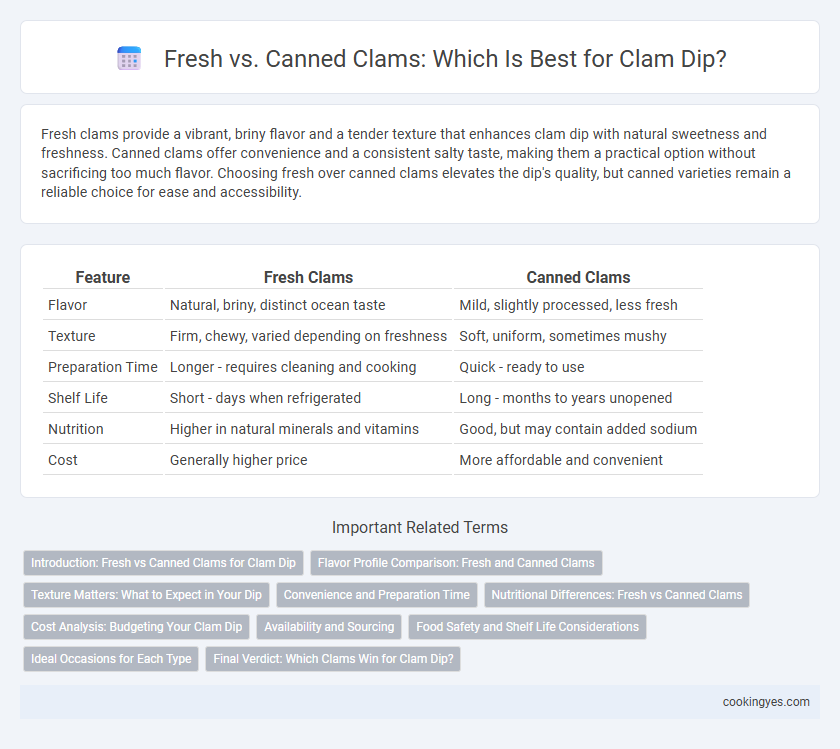Fresh clams provide a vibrant, briny flavor and a tender texture that enhances clam dip with natural sweetness and freshness. Canned clams offer convenience and a consistent salty taste, making them a practical option without sacrificing too much flavor. Choosing fresh over canned clams elevates the dip's quality, but canned varieties remain a reliable choice for ease and accessibility.
Table of Comparison
| Feature | Fresh Clams | Canned Clams |
|---|---|---|
| Flavor | Natural, briny, distinct ocean taste | Mild, slightly processed, less fresh |
| Texture | Firm, chewy, varied depending on freshness | Soft, uniform, sometimes mushy |
| Preparation Time | Longer - requires cleaning and cooking | Quick - ready to use |
| Shelf Life | Short - days when refrigerated | Long - months to years unopened |
| Nutrition | Higher in natural minerals and vitamins | Good, but may contain added sodium |
| Cost | Generally higher price | More affordable and convenient |
Introduction: Fresh vs Canned Clams for Clam Dip
Fresh clams offer a more vibrant, natural flavor and firmer texture ideal for clam dip, while canned clams provide convenience and consistent taste with a softer texture. The briny aroma and tenderness of fresh clams enhance the dip's freshness, but canned clams ensure year-round availability and ease of preparation. Selecting between fresh and canned clams ultimately affects the dip's taste profile, texture, and preparation time.
Flavor Profile Comparison: Fresh and Canned Clams
Fresh clams in clam dip deliver a briny, sweet flavor with a tender, slightly chewy texture that enhances the overall freshness of the dish. Canned clams, by contrast, offer a more concentrated, savory taste with a softer consistency due to the preservation process. The choice between fresh and canned clams directly influences the dip's flavor depth and mouthfeel, with fresh clams providing a cleaner, oceanic note and canned clams contributing a richer, more robust profile.
Texture Matters: What to Expect in Your Dip
Fresh clams offer a tender, slightly chewy texture that enhances the overall mouthfeel of clam dip with natural juiciness and subtle brininess. Canned clams, while convenient, tend to be softer and less firm, often resulting in a smoother, less textured dip with a more concentrated, sometimes saltier flavor. Choosing between fresh and canned clams directly impacts the texture profile, balancing authenticity and ease depending on personal preference and recipe requirements.
Convenience and Preparation Time
Fresh clams offer a more authentic flavor and texture but require thorough cleaning, shucking, and cooking, which can significantly increase preparation time for clam dip. Canned clams provide a convenient, ready-to-use option that eliminates the need for these labor-intensive steps, allowing for quick and easy clam dip preparation. Using canned clams ensures consistent quality and reduces preparation time, making them ideal for last-minute appetizers and busy kitchens.
Nutritional Differences: Fresh vs Canned Clams
Fresh clams offer higher levels of vitamin B12 and omega-3 fatty acids compared to canned clams, which often contain added sodium and preservatives. Canned clams provide convenience and a longer shelf life but may have reduced texture quality and slightly lower nutrient density. Choosing fresh clams enhances the intake of natural minerals like zinc and iron, critical for immune function and energy metabolism.
Cost Analysis: Budgeting Your Clam Dip
Fresh clams typically cost more per pound than canned clams, impacting the overall budget for clam dip recipes. Using canned clams reduces preparation time and waste, offering a cost-effective option without sacrificing flavor quality. When calculating expenses, factor in fresh clams' seasonal availability and market fluctuations, which can significantly affect pricing compared to the consistent cost of canned alternatives.
Availability and Sourcing
Fresh clams offer superior flavor and texture for clam dip but are often limited by seasonal availability and geographic sourcing, predominantly sourced from coastal regions with sustained harvesting regulations. Canned clams provide consistent year-round access and convenience, sourced from processing facilities that ensure preservation while maintaining clam quality. Choosing between fresh and canned depends on the balance of freshness and accessibility, with canned clams serving as a reliable option when fresh clams are off-season or unavailable locally.
Food Safety and Shelf Life Considerations
Fresh clams offer superior flavor and texture for clam dip but require immediate refrigeration and use within 1-2 days to prevent bacterial growth. Canned clams provide a safer, longer shelf life, typically lasting up to 2-5 years unopened due to sterilization processes that eliminate pathogens. Choosing between fresh or canned clams impacts the dip's food safety profile, with canned options offering convenience and reduced risk of spoilage.
Ideal Occasions for Each Type
Fresh clams provide a vibrant, briny flavor ideal for upscale gatherings, seafood feasts, and summer picnics, offering a natural and delicate taste that elevates clam dip. Canned clams are perfect for casual occasions, quick appetizers, and large parties where convenience and longer shelf life are priorities, maintaining a consistent flavor that blends well with creamy bases. Choosing between fresh and canned clams for clam dip depends on the event's style, preparation time, and desired flavor authenticity.
Final Verdict: Which Clams Win for Clam Dip?
Fresh clams provide a briny, natural flavor and firmer texture that enhances clam dip's authenticity, while canned clams offer convenience and a consistent taste profile ideal for quick preparation. Nutritionally, fresh clams are rich in vitamin B12 and omega-3 fatty acids, though canned clams retain much of their protein content and iron. For the best clam dip experience, fresh clams win in flavor and texture, but canned clams remain a reliable, accessible option.
Fresh vs Canned for clam dip Infographic

 cookingyes.com
cookingyes.com